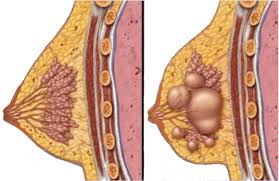Breast Cysts Causes, Symptoms, Diagnosis and Treatment

What Is A Breast Cyst?
A breast cyst is a fluid-filled sac within the breast. One breast can have one or more breast cysts.
They’re often described as round or oval lumps with distinct edges. In texture, a breast cyst usually feels like a soft grape or a water-filled balloon, but sometimes a breast cyst feels firm.
Breast cysts don’t require treatment unless a cyst is large and painful or uncomfortable. In that case, draining the fluid from a breast cyst can ease symptoms.
Breast cysts are common in women before menopause, between ages 35 and 50. But they can be found in women of any age. They can also occur in postmenopausal women taking hormone therapy.
Causes Of Breast Cyst:
The underlying cause of breast cysts is unknown.
However, they may develop as a result of hormonal changes from monthly menstruation. Some evidence suggests that excess estrogen in the body, which can stimulate the breast tissue, may contribute to breast cysts.
Breast cysts develop as a result of fluid accumulation inside the glands in the breasts.
Breast cysts may be defined by their size:
- Microcysts are too small to feel, but may be seen during imaging tests, such as mammography or ultrasound.
- Macrocysts are large enough to be felt and can grow to about 1 to 2 inches (2.5 to 5 centimeters) in diameter. Large breast cysts can put pressure on nearby breast tissue, causing breast pain or discomfort.
Symptoms Of Breast Cysts:
Signs and symptoms of breast cysts include:
- A smooth, easily movable round or oval breast lump with distinct edges
- Breast pain or tenderness in the area of the lump
- Increased lump size and tenderness just before menstruation
- Decreased lump size and resolution of other signs and symptoms after menstruation
- Having one or many simple breast cysts does not increase a person’s risk of breast cancer.
Although, having breast cysts doesn’t increase the risk of breast cancer. But having cysts may make it more difficult to find new breast lumps or other changes that might need evaluation by the doctor.
Diagnosis Of Breast Cyst:
The following tests and exams are conducted in order to diagnose breast cysts:
- Breast exam
- Breast ultrasound
- Fine-needle aspiration
Treatment Of Breast Cysts:
Breast cysts do not require treatment unless a cyst is large and painful or otherwise uncomfortable. In that case, draining the fluid from a breast cyst can ease symptoms.
The following treatment options are available:
- Needle aspiration biopsy
- Hormone therapy
- Surgery
By : Natural Health News




